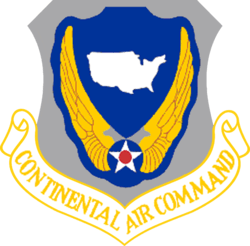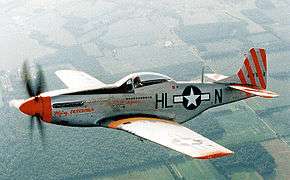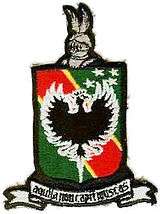305th Air Division
The 305th Air Division is an inactive United States Air Force organization. Its last assignment was with Continental Air Command, assigned to Fourth Air Force at McChord Air Force Base, Washington, where it was inactivated on 27 June 1949.
305th Air Division
 | |
|---|---|
 P-51 Mustang of the 31st Fighter Group | |
| Active | 1943–1945; 1947–1949 |
| Country | |
| Branch | |
| Role | Command of bombardment units |
| Part of | Continental Air Command |
| Motto(s) | Aquilia Non Capit Muscas Latin The Eagle Does Not Hunt Flies |
| Engagements | Mediterranean Theater of Operations |
| Commanders | |
| Lt Col Earl J. Nesbitt | 2 January 1944 |
| Lt Col Julian M. Bleyer | 14 January 1944 – April 1944 |
| Col William R. Morgan | 13 June – 9 September 1945[note 1] |
| Insignia | |
| Unofficial 305th Bombardment Wing emblem[1] |  |
The division was first activated in December 1943 as the 305th Bombardment Wing, although it was used to man other organizations and had no combat units assigned until a month after VE Day when it absorbed the assets of a provisional fighter wing, and the units of another fighter wing, but no bombardment units. When the surrender of Japan occurred, the unit no longer anticipated a transfer to the Pacific and was inactivated in September 1945. It was activated in the reserves in 1947.
History
World War II
The division was first activated at Foggia, Italy in late December 1943 as the 305th Bombardment Wing, but does not appear to have been manned until early January.[note 2] The wing had no combat components assigned until after VE Day in May 1945, and the wing commanding officer was a lieutenant colonel.[2] Instead, its personnel was used to man Fifteenth Air Force headquarters, and a provisional fighter wing which was formed in the fall of 1944.[3]
305th Fighter Wing (Provisional)
Unlike most combat air forces during World War II, Fifteenth Air Force was not assigned a fighter command. Instead, all its fighter groups were assigned to its bombardment wings until February 1944, when they were transferred to the 306th Bombardment Wing, which became the 306th Fighter Wing in May.[4][note 3] On 3 September 1944, Fifteenth formed XV Fighter Command (Provisional) and attached the 306th Wing to it. At the same time, it also organized the 305th Fighter Wing (Provisional) at Salsola Airfield[5] and attached the three groups of the 306th Wing that were flying Lockheed P-38 Lightnings (the 1st, 14th and 82d Fighter Groups) to the provisional wing. At the time, the Lightnings were the only fighter aircraft in Fifteenth Air Force that could escort its heavy bombers on strategic bombing missions until the 306th Wing's remaining groups upgraded to newer North American P-51 Mustangs.[6] The 306th Wing retained control of the groups flying the Mustang.[7][note 4]
The wing initially focused on strategic missions, such as escorting bombers.[8] After March 1945, the wing moved to Lesina Airfield[9] and its groups focused on interdiction missions against German forces in Italy, Southern Germany, Austria and Yugoslavia.[10]
On 12 June 1945, the provisional wing moved from Lesina to Torremaggiore Airfield, where the 305th Bombardment Wing was already located. It was disbanded upon arrival and its personnel assigned to the bombardment wing.[11]
Assignment of fighter groups
In addition to absorbing the personnel and headquarters of the provisional wing, the Mustang groups of the 306th Fighter Wing were also assigned to the 305th in June 1945, and the wing instituted an extensive training program in anticipation that its groups would be transferred to the Pacific to participate in the war against Japan. The 305th emphasized instrument flying and navigation; and formation, high altitude, and transition flying. One of the wing's P-51 groups also conducted experimental work in dive bombing. Pilots practiced in the Link Trainer and attended classes in engineering, air discipline, intelligence, personal equipment, air sea rescue, chemical warfare and communications procedures. However, with the surrender of Japan in August the wing began to transfer its groups to the United States at the end of August and was inactivated in Italy in September.[2]
Air Force reserve
The wing was reactivated as a reserve unit under Air Defense Command (ADC) on 12 July 1947 at McChord Field, Washington. It was assigned the 445th and 456th Bombardment Groups. which were activated the same day at McChord[12] In October, the 454th Bombardment Group was activated at McChord and assigned to the wing.[13] The three groups were all designated as very heavy units, and nominally were Boeing B-29 Superfortress units. However, there is no indication that the groups were equipped with tactical aircraft.[14] Regular Air Force support for reserve training at McChord was provided by the 2345th Air Force Reserve Training Center.[15]
In 1948, Continental Air Command assumed responsibility from ADC for managing Air National Guard and reserve units.[16] When the regular Air Force implemented the wing base organization system, which placed operational and support units on a base under a single wing that same year, the 305th Wing, along with other reserve wings with more than one combat group assigned, was redesignated as an air division.[2]
The 305th participated in routine reserve training and supervised the training of its three assigned groups until all were inactivated, in part due to President Truman’s 1949 defense budget, which required reductions in the number of units in the Air Force,[17] Most of their equipment and personnel were used to form the 302d Troop Carrier Wing, which was simultaneously activated at McChord.[2][18]
Lineage
- Established as the 305th Bombardment Wing (Heavy) on 7 December 1943
- Activated on 29 December 1943
- Redesignated 305th Bombardment Wing, Heavy c. 4 May 1945
- Inactivated on 9 September 1945
- Redesignated 305th Bombardment Wing, Very Heavy on 13 May 1947
- Activated in the Reserve on 12 July 1947
- Redesignated 305th Air Division, Bombardment on 16 April 1948
- Inactivated on 27 June 1949[2]
Assignments
- Fifteenth Air Force, 29 December 1943 – 9 September 1945
- Fourth Air Force, 12 July 1947 – 27 June 1949[2]
Stations
Components
- Fighter Groups (1945)
- 1st Fighter Group: c. 13 June – c. 9 September 1945
- Lesina Airfield, Italy[19]
- 14th Fighter Group: c. 13 June – 9 September 1945
- Triolo Airfield, Italy to September 1945, Lesina Airfield, Italy[20]
- 31st Fighter Group: c. 13 June – 9 September 1945
- Mondolfo Airfield, Italy to 15 July 1945, Triolo Airfield, Italy to August 1945[21]
- 52d Fighter Group: 13 June – c. 30 August 1945
- Piagiolino Airfield, Italy to 8 July 1945, Lesina Airfield, Italy to 10 August 1945[22]
- 82d Fighter Group: 3 – 9 September 1945
- Vincenzo Airfield, Italy to x. 30 August 1945, Lesina Airfield, Italy[23]
- 325th Fighter Group: 13 June – c. 30 August 1945
- Mondolfo Airfield, Italy to July 1945, Vincenzo Airfield, Italy[24]
- 332d Fighter Group: 13 June – c. 9 September 1945
- Cattolica Airfield, Italy to c. 18 July 1945, Lucera Airfield, Italy[25][note 5]
- Bombardment Groups (1947–1948)
- 445th Bombardment Group: 12 July 1947 – 27 June 1949
- 454th Bombardment Group: 17 October 1947 – 27 June 1949
- 456th Bombardment Group: 12 July 1947 – 27 June 1949[2]
Aircraft
Campaigns
| Campaign Streamer | Campaign | Dates | Notes |
|---|---|---|---|
| Naples-Foggia | 29 December 1943 – 21 January 1944 | 305th Bombardment Wing[2] | |
| Rome-Arno | 22 January 1944 – 9 September 1944 | 305th Bombardment Wing[2] |
References
Notes
- Commanders during the years as a reserve unit are unknown. AFHRA Factsheet, 305 Air Division
- No commanding officer was assigned until 2 January. AFHRA Factsheet,305th Air Division.
- Despite the healthy number of fighter groups assigned in the spring of 1944, the groups were short of fighter aircraft and most of those on hand, including the early model Mustangs, were too short ranged to perform adequate escort duty. Simpson, Vol. III, p. 570
- Fifteenth fighter units had been flying earlier, shorter-ranged models of the Mustang, but Eighth Air Force was given priority for the delivery of new Mustanges. Simpson, Vol. III, p. 570.
- The 31st and 52d Groups left for United States while still assigned to the wing. The remaining groups were reassigned or inactivated when the wing was inactivated.
Citations
- See Maurer, p. 417 (no emblem approved for unit)
- "Factsheet 305 Air Division, Bombardment". Air Force Historical Research Agency. 5 October 2007. Archived from the original on 29 November 2012. Retrieved 28 March 2014.
- Simpson, Vol. II, p. 336
- See Maurer, pp. 417–418 (assignment of 1st, 14th, 31st, 52d, 82d, 325th and 332d Fighter Groups in 1944).
- "Abstract, History 305 Fighter Wing (Provisional) Sep 1944". Air Force History Index. Retrieved 29 March 2016.
- Simpson, Vol. III, p. 570
- Combat Chronology of the United States Army Air Force, September 1944
- See "Abstract, History 305 Fighter Wing (Provisional) April 1945". Air Force History Index. Retrieved 29 March 2016. (switch from strategic to tactical missions).
- "Abstract, History 305 Fighter Wing (Provisional) March 1945". Air Force History Index. Retrieved 29 March 2016.
- "Abstract, History 305 Fighter Wing (Provisional) Dec 1944". Air Force History Index. Retrieved 29 March 2016.
- "Abstract, History 305 Fighter Wing (Provisional) Jun 1945". Air Force History Index. Retrieved 29 March 2016.
- Maurer, pp. 319–320, 331–332
- Maurer, p. 330
- See AFHRA Factsheet, 305 Air Division (no aircraft listed as assigned from 1947 to 1949).
- "Abstract, History 2345 Air Force Reserve Training Center Jul–Dec 1948". Air Force History Index. Retrieved 31 March 2016.
- "Abstract, Mission Project Closeup, Continental Air Command". Air Force History Index. 27 December 1961. Retrieved 24 March 2014.
- Knaack, p. 25
- Ravenstein, pp. 147–149
- Maurer, p. 23
- Maurer, p. 58
- Maurer, p. 85
- Maurer, p. 114
- Maurer, p. 148
- Maurer, p. 207
- Maurer, p. 213
Bibliography
![]()
- Simpson, Albert F. (1949). "Sicily and Southern Italy, Chapter 16, The Fifteenth Air Force". In Craven, Wesley F; Cate, James L (eds.). The Army Air Forces in World War II (PDF). Vol. II, Europe: Torch to Pointblank. Chicago, Illinois: University of Chicago Press. LCCN 48003657. OCLC 704158. Retrieved 28 October 2015.
- Simpson, Albert F. (1951). "Italy, Chapter 10, Anzio". In Craven, Wesley F; Cate, James L (eds.). The Army Air Forces in World War II (PDF). Vol. III, Europe: Argument to V-E Day. Chicago, Illinois: University of Chicago Press. LCCN 48003657. OCLC 704158. Retrieved 28 October 2015.
- Knaack, Marcelle Size (1978). Encyclopedia of US Air Force Aircraft and Missile Systems. Vol. 2, Post-World War II Bombers 1945–1973. Washington, DC: Office of Air Force History. ISBN 0-912799-59-5.
- Maurer, Maurer, ed. (1983) [1961]. Air Force Combat Units of World War II (PDF) (reprint ed.). Washington, DC: Office of Air Force History. ISBN 0-912799-02-1. LCCN 61060979.
- Ravenstein, Charles A. (1984). Air Force Combat Wings, Lineage & Honors Histories 1947–1977. Washington, DC: Office of Air Force History. ISBN 0-912799-12-9.
.svg.png)